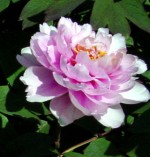 For large beautiful flowers it is hard to beat the tree peony. Grown in China for over a thousand years, tree peony is a deciduous shrub with spreading branches growing about three to five feet tall and three to four feet wide. Even without flowers or leaves the plant is attractive in winter with its graceful branching structure. The dark green leaves are deeply dissected and remain attractive throughout the summer. The flowers of the species appear in spring and are six to eight inches across with white to pink petals that bear purple patches at their base. Many cultivars, however, have been developed that are fragrant, twelve inches across and are red, yellow, maroon, purple, and green. Flowers last about ten days on the bush and are also good cut flowers. Tree peony can be tricky to grow but once established requires little care. It needs to be planted in autumn about six weeks before the first frost to give the roots time to grow. Grafted cultivars should be planted so that the union is at least four inches below the ground to encourage the grafts to form their own roots. Several years are required to grow to blooming size but if the plant likes its location it will be longed lived. It needs excellent drainage, four to five house of sun with morning sun best, and protection from wind. These shrubs are beautiful in the middle or back of borders, used as accents as specimens or in a group, and can be used as hedges because of their suckering tendency.
For large beautiful flowers it is hard to beat the tree peony. Grown in China for over a thousand years, tree peony is a deciduous shrub with spreading branches growing about three to five feet tall and three to four feet wide. Even without flowers or leaves the plant is attractive in winter with its graceful branching structure. The dark green leaves are deeply dissected and remain attractive throughout the summer. The flowers of the species appear in spring and are six to eight inches across with white to pink petals that bear purple patches at their base. Many cultivars, however, have been developed that are fragrant, twelve inches across and are red, yellow, maroon, purple, and green. Flowers last about ten days on the bush and are also good cut flowers. Tree peony can be tricky to grow but once established requires little care. It needs to be planted in autumn about six weeks before the first frost to give the roots time to grow. Grafted cultivars should be planted so that the union is at least four inches below the ground to encourage the grafts to form their own roots. Several years are required to grow to blooming size but if the plant likes its location it will be longed lived. It needs excellent drainage, four to five house of sun with morning sun best, and protection from wind. These shrubs are beautiful in the middle or back of borders, used as accents as specimens or in a group, and can be used as hedges because of their suckering tendency.
Type: Deciduous shrub
Outstanding Features: Flowers
Form: Upright, open, leggy
Growth Rate: Slow
Bloom: Pink or white flowers 6-8′ across in spring; many cultivars have larger, fragrant flowers in red, maroon, purple, and yellow.
Size: 4-10′ H x 4-10′ W
Light: Dappled shade with 2-3 hours of sun is best; morning sun in the South
Soil: Rich, moist, well drained, high in organic matter
Hardiness: Zones 5-9
Care: Mulch the first year but not after that; remove faded flowers to control botrytis fungus; stake stems with large flowrs; prune to remove unwanted suckers, dead wood and side shoots.
Pests and Diseases:Susceptible to Botrytis blight, tip blight, stem rot, Verticillium wilt, ringspot virus, leaf blotch, nematodes, and Japanese beetles.
Propagation: Semi-hardwood cuttings in late summer; graft in winter
Outstanding Selections: Many beautiful cultivars available.
